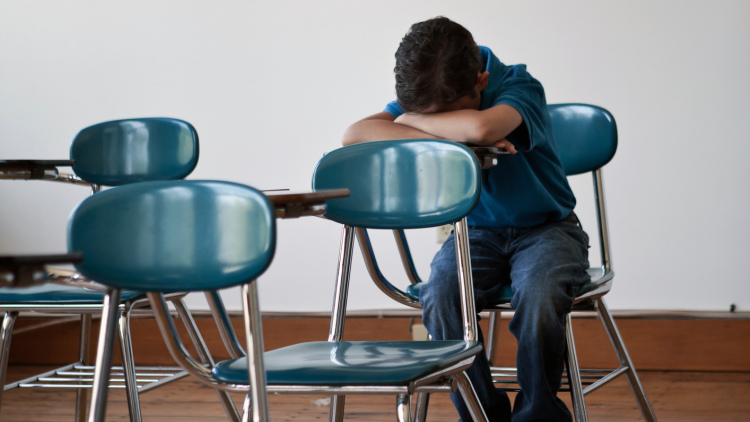School Discipline Linked to Later Consequences
- Posted September 16, 2019
- By Emily Boudreau

Since the emergence of zero tolerance discipline policies in the 1990s, schools have increasingly relied on suspensions as a behavioral management tactic. But these policies can potentially stigmatize students and expose them to the criminal justice system. A field of developing research strongly suggests a correlation between school discipline and the likelihood of dropping out, arrests, and incarceration.
A working paper recently published by the National Bureau of Economic Research reports some of the first causal evidence that strict schools do indeed contribute to the so-called school-to-prison pipeline. The study’s authors are Andrew Bacher-Hicks and David Deming of Harvard University and Stephen Billings of the University of Colorado–Boulder.
The study explores the relationship between suspensions, achievement, and incarceration in the Charlotte-Mecklenberg school district (CMS) in North Carolina, in which 23% of middle school students are suspended each school year and suspensions are concentrated heavily among minority populations.
CMS provided a rigorous way to test the causal effects of suspensions because, in 2002, schools were redistricted and roughly 50% of all students were assigned to new schools that fall. This new assignment meant researchers had access to an ideal sample: students from the same neighborhood, some of whom had attended schools with a high rate of suspension and now attended schools with a lower rate, others who had moved from a less-strict school to one with more suspensions, and students whose school had not changed.
Researchers used available school administrative records, data on arrests and incarcerations, and college attendance records to assess the impact of school environments on later life outcomes.

Broad Takeaway:
Students assigned to high-suspension schools are more likely to be arrested and incarcerated later, and less likely to attend a four-year college. Male minority students are most likely to be affected.
The Findings
“One of the arguments in favor of suspensions is that if a student is removed from the classroom, they’re no longer causing disruptions, and so removing disruptive students could have positive benefits on those who remain in the classroom,” says Bacher-Hicks, a Ph.D. candidate in public policy at Harvard. “But we found for all students, there are large negative impacts on later-life outcomes, related to attending a school with a high suspension rate. That suggests there are not overwhelmingly positive benefits of removing disruptive peers from the classroom.”
- Even though half of all CMS students attended a new school for the 2002–2003 school year, original suspension rates stayed largely the same at each school, even though half of the student population had been redistricted. This finding suggests that suspensions are the result of policies, rather than student population.
- Students assigned to a school with a one standard deviation higher suspension rate are 15–20% more likely to be arrested and incarcerated as adults and were also less likely to attend a four-year college.
- Male minority students were most likely to be affected negatively by stricter school policy.
- The study also demonstrated that school effects on suspensions was unrelated to other features like teacher turnover, school quality, and student composition.
- But there was a clear correlation between school effects and school leadership, suggesting that variation in suspension policy happens at the school leadership level.
Suspensions did not have a statistically significant impact on positive student achievement overall. No long-term benefits were found in any represented subgroup. “We tested a range of variables, and only one short-run benefit popped out for any subgroup: There was some evidence that test scores increased for non-minority males. But even for that subgroup, we find negative long-run outcomes in terms of arrests and incarcerations,” Bacher-Hicks says.
"We found for all students, there are large negative impacts on later-life outcomes, related to attending a school with a high suspension rate. That suggests there are not overwhelmingly positive benefits of removing disruptive peers from the classroom.” – Andrew Bacher-Hicks
How to Use this Knowledge: School Discipline
- Education professionals should be cautious of relying heavily on exclusionary practices. A strict school climate negatively impacts long-run outcomes — educational attainment, arrests, and incarceration rates — for the overall student body.
- Professionals wishing to address achievement gaps or criminal justice outcomes should consider reimagining school disciplinary measures as a lever for change. Male minority students are disproportionately affected by suspensions and strict policies, and this bias almost certainly contributes to existing gaps in educational attainment and criminal justice outcomes.
- School leaders play a key role in setting disciplinary policy. Leaders should recognize that power and think about the impacts of discretionary choices before suspending a student.
- Consider alternatives to suspensions. An Obama-era guidance issued in 2014 hoped to address the potential negative implications of school suspensions and disciplinary practices. It suggested alternative practices based in positive reinforcement and a restorative process for students re-entering the classroom following disciplinary action.
- Gather data to support best practices. While this study finds that suspensions have a negative impact on later life outcomes, there isn’t much research to support disciplinary approaches that positively affect later outcomes. Researchers should look at schools and districts implementing alternative practices to develop future studies.
Read the working paper from the National Bureau of Economic Research.

Usable Knowledge
Connecting education research to practice — with timely insights for educators, families, and communities

Related Articles

The Disparate Toll of Police Violence
A new study examines the impact of police killings on student outcomes

Discipline in Schools: Why is Hitting Still an Option?
A pediatrician discusses the prevalence and effects of corporal punishment in schools, and what it might take to end it for good

HGSE Campaign Launch Video

IMAGES
VIDEO
COMMENTS
To explore the potential for gaming, qualitative research could offer a greater understanding of whether or not the decline in disciplinary outcomes aligns with the dynamics within schools. ... Mediratta K., Rausch K. M. (Eds.), Inequality in school discipline: Research and practice to reduce disparities (pp. 115-134). New York, NY: Palgrave ...
School discipline is an issue of utmost importance to educational policymakers, researchers, practitioners, and stakeholders because of long-standing disparities in who receives punishment and experiences the impact of exclusionary discipline on education and long-term life outcomes. Students with disabilities, non-heterosexual youth, low-socioeconomic-status students, low-performing students ...
During the 2011-2012 school year, NCES (2014) reported that there were 3.4 million in-school suspensions and 3.2 million out-of-school suspensions in public schools in the United States. There is research that suggests a relationship between exclusionary discipline policies and juvenile delinquency; however, this phenomenon has not been
Wallace, & Bachman, 2008). There have been policy responses to solve the school discipline dilemma. The Gun-Free Schools Act of 1994 and zero-tolerance school discipline policies are widely considered as responses to the mid-1990s' spike in school violence. In response to discipline disparities, there are emerging policy
manage discipline problems among learners. I employed a qualitative approach to collecting data. This facilitated meaning making from the data by considering the bigger picture and converting the raw empirical information into what is known in qualitative research as 'thick description'.
A field of developing research strongly suggests a correlation between school discipline and the likelihood of dropping out, arrests, and incarceration. A working paper recently published by the National Bureau of Economic Research reports some of the first causal evidence that strict schools do indeed contribute to the so-called school-to ...
Keywords: school discipline, high school, qualitative research Introduction School discipline continues to be a problem for teachers. A national teacher survey showed that over half of the teachers perceived that across all grade levels, student behavior has worsened within their last five years of
out-of-school suspensions which have iatrogenic impacts at school and the community that both reflect and rein-force marginalization and institutionalized racism (e.g., Mittleman, 2018). Moreover, the dual pandemics of COVID-19 and racism have underscored concern that racial disparities in school discipline and their sequelae
Author note: The development of this research was supported by the Institute of Education Sciences, U.S. Department of Education (#R324A170034). The opinions expressed are those of ... to racial equity in school discipline practice: A qualitative study of critical incidents. Journal of Educational and Psychological Consultation, 1-31.
Intersectional inquiries with LGBTQ and gender nonconforming youth of color: Participatory research on discipline disparities at the race/sexuality/gender nexus. In Skiba R. J., Mediratta K., Rausch M. K. (Eds.), Inequality in school discipline: Research and practice to reduce disparities (pp. 171-188). New York, NY: Palgrave MacMillan.